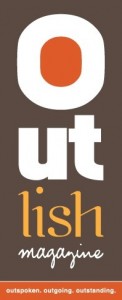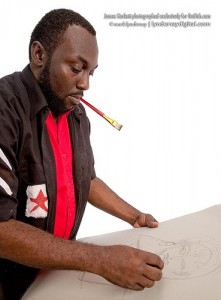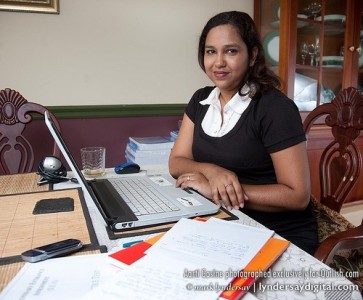 Outlish Magazine is a new, weekly, online magazine targeted at young adult Trinbagonians. It showcases people who are going after their dreams and features fresh perspectives on issues that readers obviously relate to, because its popularity is soaring. I decided to find out what makes Outlish the newest “in” thing by talking with its founder and Editor-in-Chief, Karel Mc Intosh…
Outlish Magazine is a new, weekly, online magazine targeted at young adult Trinbagonians. It showcases people who are going after their dreams and features fresh perspectives on issues that readers obviously relate to, because its popularity is soaring. I decided to find out what makes Outlish the newest “in” thing by talking with its founder and Editor-in-Chief, Karel Mc Intosh…
Janine Mendes-Franco: You were blogging intermittently at Caribbean Public Relations, contributing occasional posts to Global Voices Online and working for “The Man” in a marketing job when you decided to follow through with creating this online magazine you'd had your heart set on for a while. How did you make the move and why did you feel there was room for it in a largely traditional market?
Karel Mc Intosh: I started blogging in June 2006 at CPR and maintained it for quite a bit until things started to get very hectic as I moved up in the corporate world. When I left my job, I was holding a managerial position, which for some is a big deal. I don’t care much for titles; I’m more concerned about doing things that I enjoy and which push me to be constantly creating. I was feeling stifled and frustrated, so I left. Just before that, the vision for Outlish started cementing itself in my mind, and I decided since I now had the free time, I’d start the magazine.
I’ve been blogging for the past few years, I’m a total Internet junkie, and I love magazines. Being a digital native, online was the obvious choice for me, so I went with it. Not to mention the start-up costs are incredibly low.

Karel Mc Intosh, Founder and Editor-in-Chief, Outlish Magazine. Photo by Mark Lyndersay, used with permission.
When I started Outlish I didn’t care about competition and whether there was space for it in the market. This was more a project of passion and love than trying to find a way to make money. Most of my favourite magazines and websites are foreign-based, and I know it’s like that for many Trinbagonians. I wanted to see something that dealt with issues that I was interested in, without getting too intellectual. The number of people using the Internet in Trinidad and Tobago alone is growing every single year. Look at Facebook. You’re seeing people online every day, posting links to articles they like and discussing various issues, so I knew there were tons of people who would be interested in what Outlish would be offering. Besides, once you’re online, your audience is literally the world. I’ve started out by focusing on T&T. The ultimate goal is to eventually widen our scope [of content] to the wider Caribbean.
JMF: What went into the mag's creation technically and creatively? And why the name?
KMI: I wanted something that represented the idea of being different and operating outside of the box. Popular media tends to focus on what’s in, and there are people out there who don’t care about what’s in or what the trends are and prefer to ascribe to their own individual path. So that’s what I wanted the name to represent. I went through a slew of names. The thing about being online though, is so many people have parked domains or have taken up names, so it’s hard to get the domain name you want. I wanted something short and sweet. I’d seen the name online sometime before and liked it, and it kind of always stayed with me. When I checked to see if the name was available and it was, I registered it immediately.
There was a lot of fine-tuning that went into solidifying Outlish’s vision. I wanted to ensure that what I had set out to achieve was sustainable, so I’m very much conscious of how ideas impact work flows; what’s achievable and manageable. I got help with creating the brand. My friend Jeunanne Alkins designed the logo and was a great sounding board. Other people's support and interest in what I was doing [like that of Assistant Editor, Quilin Achat] was also very encouraging, especially when I’d stop and ask myself, “Karel what yuh really doing?” I had also started a Coming Soon page that gave an overview of Outlish, a Twitter account, and the Facebook fan page very early on so that people could start engaging with the brand and give feedback on what they wanted to see before we even published it. Readers were regularly emailing to say how much they loved what Outlish represented, so this provided a lot of encouragement and told me that my intuition was strong.
On the technical side, a fellow blogger, Ndelamiko Lord designed the website. She’s also known as Sun Goddess for her blog. Funnily enough, Ndelamiko helped lay the seed for my desire to start a magazine years ago! She had a digital magazine called Sunhead Magazine, which I read religiously and thought was so cool. We’d been chatting on Facebook, and so when plans with the original website designer fell through, Ndelamiko was a saviour. It’s funny, the Caribbean blogosphere and tech community has so many talented people, and I’m just glad for the support I’ve been getting. I have to give a special shoutout to the #WITArmy (West Indian Twitter Army). They’re an especially feisty and supportive group. I swear we have some of the coolest people on Twitter. Our Chief Photographer Mark Lyndersay is the man responsible for the amazing photos you see of all our interviewees and a real tech geek. He’s also on Twitter. So we’ve got some true techies on board the Outlish train.
JMF: Do you think Outlish is changing the landscape of social media locally? How do you measure effectiveness?
KMI: Well, I think it’s important to keep the fun in it, although I do plan to monetise Outlish Magazine. However, I think it’s important to keep the essence of it strong, which is to provide a space where young Trinis can see themselves and their peers going after and achieving their dreams, with no fear of what others may think about them. I’m a big believer in the ability to achieve anything you set your mind to as long as you plan well and pray hard.
So far, I’ve been getting really great feedback. People tell me they check the site several times a week, and they especially love the interviews we do. I wouldn’t try to give Outlish kudos for changing the social media landscape locally, though I’ve seen it mentioned in social media discussions on traditional media talk shows. I think what it does is show people, hey if you have a great grasp of social media, you can create an online community, really forge relationships and create something that’s dynamic.
I keep listening to the feedback that we get on Facebook, Twitter, blog mentions, emails, and conversations with people I meet. That helps keep me clued into what people like. I’m also very open to suggestions. I know what I want Outlish to be, and a part of that is ensuring that readers and contributors have a hand in helping to shape it. Outlish is a forum for expression, and we rely on our readers to help guide the conversation. At Outlish, we’re focusing on the up n’ coming, under the radar folks, who are really interesting personas. Sometimes the guy living next door is way more interesting than a celebrity. We think it’s way more fun to find out what’s out there instead of getting caught up with what’s ‘in’. So we’re going to keep featuring people 40 and under who have interesting viewpoints and are going after their destiny. Basically, our measurement criteria rest on how much we inspire and empower people through the content we feature. We’re not just a magazine. Outlish is a movement. As long as people are being inspired, Outlish is being true to what it has set out to accomplish.
JMF: How do you choose which stories to feature?
KMI: There isn’t really any scientific method. We celebrate individuality, so we feature people who represent that and who, in their own ways, are inspirations to others. We look for people with an entrepreneurial, adventurous spirit. Whether it’s an artist, entrepreneur or activist, there’s a thread running through all of our features – these people know what they want to do, what they love to do, and they’re trying to accomplish it despite the odds.

James Hackett, Illustrator, Folklore Lover and Fashion Student. Photo by Mark Lyndersay, used with permission.
We keep looking for people, asking readers for suggestions, and people email us asking for interviews. If people are sending suggestions, we ask them to send links where we can find more info on the person, and we take it from there. Typically we feature one person a week, sometimes two. We’ve got a vault of people to still feature. We try to plan pretty far in advance. The great thing about having Outlish is that I get to meet so many talented, cool, inspiring young people, and that keeps me motivated to do what I’m doing. Regarding issue-based stories, we look at what’s going on, what sort of aspirations our readers have, the issues that affect them and just things that are interesting in general. Or I might hear someone say something, and may like a phrase they use and I get inspiration from that. People have varied interests, and sometimes they just like to go to a site and be able to pull from a wide range of topics. It’s sort of having a mashup of things you like. So we try to mash it up. We really don’t have any rules or a set formula. It’s all spontaneous for the most part too. So we might plan an issue in advance, and switch it around at the last minute. I love the organised chaos.
JMF: Advertising is obviously one route to help keep this thing going. Do you think corporate T&T understands the potential of citizen media and online social media in general?
KMI: I think that some companies are slowly understanding the role it plays. Due to the fact that traditional media is still very strong in T&T, some may feel that it isn’t all that important. However, I think the power has certainly shifted to the people. If we don’t like a brand, we can create a community page or blast them on a blog or Facebook. People are certainly becoming more vocal online. You can see that they’re serious about social media as a communications channel. Some merely advertise or they create a page and use it purely as a news release system. Companies still have a fear of being chastised online or receiving negative feedback. But in the digital world, people trust you more when you can “take talk” too. I think they understand that social media is here to stay; it isn’t a fad. Whether they understand the true potential? I don’t think so.
The worst thing is to underestimate what people can accomplish through social media. In 2009, Outlish wasn’t something people may have anticipated. I was able to mobilise it in mere months. As users become more savvy, it’s going to totally open up how we communicate and the various media we pull information from. We’re already seeing it. What I would tell companies is that social media is not just about numbers. You’ve got to look at influencers, and the type of people who are engaging with brands or sites. Outlish is fortunate in that it has the support of online influencers. Maybe that’s because I come from the first batch of Caribbean bloggers, and so I have genuine relationships with people. It’s not just about putting an ad on a daily newspaper’s website now. You’ve got to find the spaces where people congregate and hang out online to have discussions and offer their views. That’s where you’ve got to go to engage people.
JMF: How have you been using more established social media platforms to raise awareness of the existence of Outlish?
KMI: Social media has played a key role in developing the Outlish community. I haven’t done any sort of promotion in traditional media. Facebook, Twitter, our coming soon page, which was very much linked into our social networking, and word of mouth played a key role. Through social media, I also was able to meet new people and discover new things. I did very little Facebook advertising. Spent maybe TT$120 on that to promote the website early on. When we actively launched the site, we didn’t do any advertising. It was purely based on sending info out through news feeds and depending on the anticipation people had. I t paid off. So far, word of mouse (clickety click) has been the real driver of traffic to the site. Obviously, traffic is a huge consideration, but I’m also very much interested in a loyal readership and ensuring that the magazine really excites people about their own lives. I don’t set out to promote the brand per se, but more specifically I set out to form relationships, and to help promote all the talented peeps we don’t hear about. For example, I hardly use Twitter to promote Outlish. I’m on there every day, chatting with people, supporting other people’s projects and just having a blast. Call it the outgoing part of Outlish in me, but we use social media to engage people and to discover what’s out there, so we can share what we’ve found with our readers.









10 comments
Thanks for the opportunity Janine. Throughly enjoyed doing the interview :)
Glad to see this Karel deserves all the good that comes her way, a passionate person and obviously hard worker.
Cool magazine and great pic of the founder and editor-in-chief.
great stuff! The sky is the limit!!
An inspiring story, good luck to you and Outlish :)
Thanks for the continuous support guys. The good vibes definitely keep us going :)
Admiration x infinity..
Blessings and miracles
Outlish has published some great photos in its short life of interesting people. For those not on Facebook, here’s a gallery of some of those images: http://lyndersaydigital.com/tvg/xibit/outlish.html
That gallery is now here: https://lyndersaydigital.com/outlish/